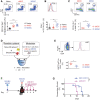Donor myeloid derived suppressor cells (MDSCs) prolong allogeneic cardiac graft survival through programming of recipient myeloid cells in vivo
- PMID: 32859934
- PMCID: PMC7455707
- DOI: 10.1038/s41598-020-71289-z
Donor myeloid derived suppressor cells (MDSCs) prolong allogeneic cardiac graft survival through programming of recipient myeloid cells in vivo
Abstract
Solid organ transplantation is a lifesaving therapy for patients with end-organ disease. Current immunosuppression protocols are not designed to target antigen-specific alloimmunity and are uncapable of preventing chronic allograft injury. As myeloid-derived suppressor cells (MDSCs) are potent immunoregulatory cells, we tested whether donor-derived MDSCs can protect heart transplant allografts in an antigen-specific manner. C57BL/6 (H2Kb, I-Ab) recipients pre-treated with BALB/c MDSCs were transplanted with either donor-type (BALB/c, H2Kd, I-Ad) or third-party (C3H, H2Kk, I-Ak) cardiac grafts. Spleens and allografts from C57BL/6 recipients were harvested for immune phenotyping, transcriptomic profiling and functional assays. Single injection of donor-derived MDSCs significantly prolonged the fully MHC mismatched allogeneic cardiac graft survival in a donor-specific fashion. Transcriptomic analysis of allografts harvested from donor-derived MDSCs treated recipients showed down-regulated proinflammatory cytokines. Immune phenotyping showed that the donor MDSCs administration suppressed effector T cells in recipients. Interestingly, significant increase in recipient endogenous CD11b+Gr1+ MDSC population was observed in the group treated with donor-derived MDSCs compared to the control groups. Depletion of this endogenous MDSCs with anti-Gr1 antibody reversed donor MDSCs-mediated allograft protection. Furthermore, we observed that the allogeneic mixed lymphocytes reaction was suppressed in the presence of CD11b+Gr1+ MDSCs in a donor-specific manner. Donor-derived MDSCs prolong cardiac allograft survival in a donor-specific manner via induction of recipient's endogenous MDSCs.
Conflict of interest statement
The authors declare no competing interests.
Figures






Similar articles
-
Dexamethasone-Induced Myeloid-Derived Suppressor Cells Prolong Allo Cardiac Graft Survival through iNOS- and Glucocorticoid Receptor-Dependent Mechanism.Front Immunol. 2018 Feb 15;9:282. doi: 10.3389/fimmu.2018.00282. eCollection 2018. Front Immunol. 2018. PMID: 29497426 Free PMC article.
-
The mTOR Deficiency in Monocytic Myeloid-Derived Suppressor Cells Protects Mouse Cardiac Allografts by Inducing Allograft Tolerance.Front Immunol. 2021 Apr 9;12:661338. doi: 10.3389/fimmu.2021.661338. eCollection 2021. Front Immunol. 2021. PMID: 33897705 Free PMC article.
-
Analysis of therapeutic potential of monocytic myeloid-derived suppressor cells in cardiac allotransplantation.Transpl Immunol. 2021 Aug;67:101405. doi: 10.1016/j.trim.2021.101405. Epub 2021 May 8. Transpl Immunol. 2021. PMID: 33975012
-
Myeloid-Derived Suppressor Cells in the Context of Allogeneic Hematopoietic Stem Cell Transplantation.Front Immunol. 2020 May 22;11:989. doi: 10.3389/fimmu.2020.00989. eCollection 2020. Front Immunol. 2020. PMID: 32528476 Free PMC article. Review.
-
Myeloid-derived suppressor cells in transplantation tolerance induction.Int Immunopharmacol. 2020 Jun;83:106421. doi: 10.1016/j.intimp.2020.106421. Epub 2020 Mar 24. Int Immunopharmacol. 2020. PMID: 32217462 Review.
Cited by
-
MerTK-dependent efferocytosis by monocytic-MDSCs mediates resolution of ischemia/reperfusion injury after lung transplant.JCI Insight. 2024 Aug 22;9(19):e179876. doi: 10.1172/jci.insight.179876. JCI Insight. 2024. PMID: 39172530 Free PMC article.
-
An In Vivo Mouse Model for Chronic Inflammation-Induced Immune Suppression: A "Factory" for Myeloid-Derived Suppressor Cells (MDSCs).Curr Protoc. 2022 Sep;2(10):e558. doi: 10.1002/cpz1.558. Curr Protoc. 2022. PMID: 36239438 Free PMC article.
-
Designing Chimeric Antigen Receptors for Myeloid Immune Cells.J Cancer Biol Res. 2024;11(1):1144. Epub 2024 Jun 16. J Cancer Biol Res. 2024. PMID: 40256427 Free PMC article.
-
Early Myeloid Derived Suppressor Cells (eMDSCs) Are Associated With High Donor Myeloid Chimerism Following Haploidentical HSCT for Sickle Cell Disease.Front Immunol. 2021 Nov 30;12:757279. doi: 10.3389/fimmu.2021.757279. eCollection 2021. Front Immunol. 2021. PMID: 34917079 Free PMC article.
-
Harnessing bioengineered myeloid progenitors for precision immunotherapies.NPJ Regen Med. 2023 Dec 12;8(1):66. doi: 10.1038/s41536-023-00343-x. NPJ Regen Med. 2023. PMID: 38086850 Free PMC article. Review.
References
-
- Hart A, Smith JM, Skeans MA, Gustafson SK, Wilk AR, Castro S, Robinson A, Wainright JL, Snyder JJ, Kasiske BL, Israni AK. OPTN/SRTR 2017 annual data report: kidney. Am. J. Transplant. 2019;19(Suppl 2):19–123. - PubMed
-
- Kim WR, Lake JR, Smith JM, Schladt DP, Skeans MA, Noreen SM, Robinson AM, Miller E, Snyder JJ, Israni AK, Kasiske BL. OPTN/SRTR 2017 annual data report: liver. Am. J. Transplant. 2019;19(Suppl 2):184–283. - PubMed
-
- Valapour M, Lehr CJ, Skeans MA, Smith JM, Uccellini K, Lehman R, Robinson A, Israni AK, Snyder JJ, Kasiske BL. OPTN/SRTR 2017 annual data report: lung. Am. J. Transplant. 2019;19(Suppl 2):404–484. - PubMed
-
- Colvin M, Smith JM, Hadley N, Skeans MA, Uccellini K, Lehman R, Robinson AM, Israni AK, Snyder JJ, Kasiske BL. OPTN/SRTR 2017 annual data report: heart. Am. J. Transplant. 2019;19(Suppl 2):323–403. - PubMed
-
- Kandaswamy R, Stock PG, Gustafson SK, Skeans MA, Urban R, Fox A, Odorico JS, Israni AK, Snyder JJ, Kasiske BL. OPTN/SRTR 2017 annual data report: pancreas. Am. J. Transplant. 2019;19(Suppl 2):124–183. - PubMed
Publication types
MeSH terms
Grants and funding
LinkOut - more resources
Full Text Sources
Medical
Research Materials

